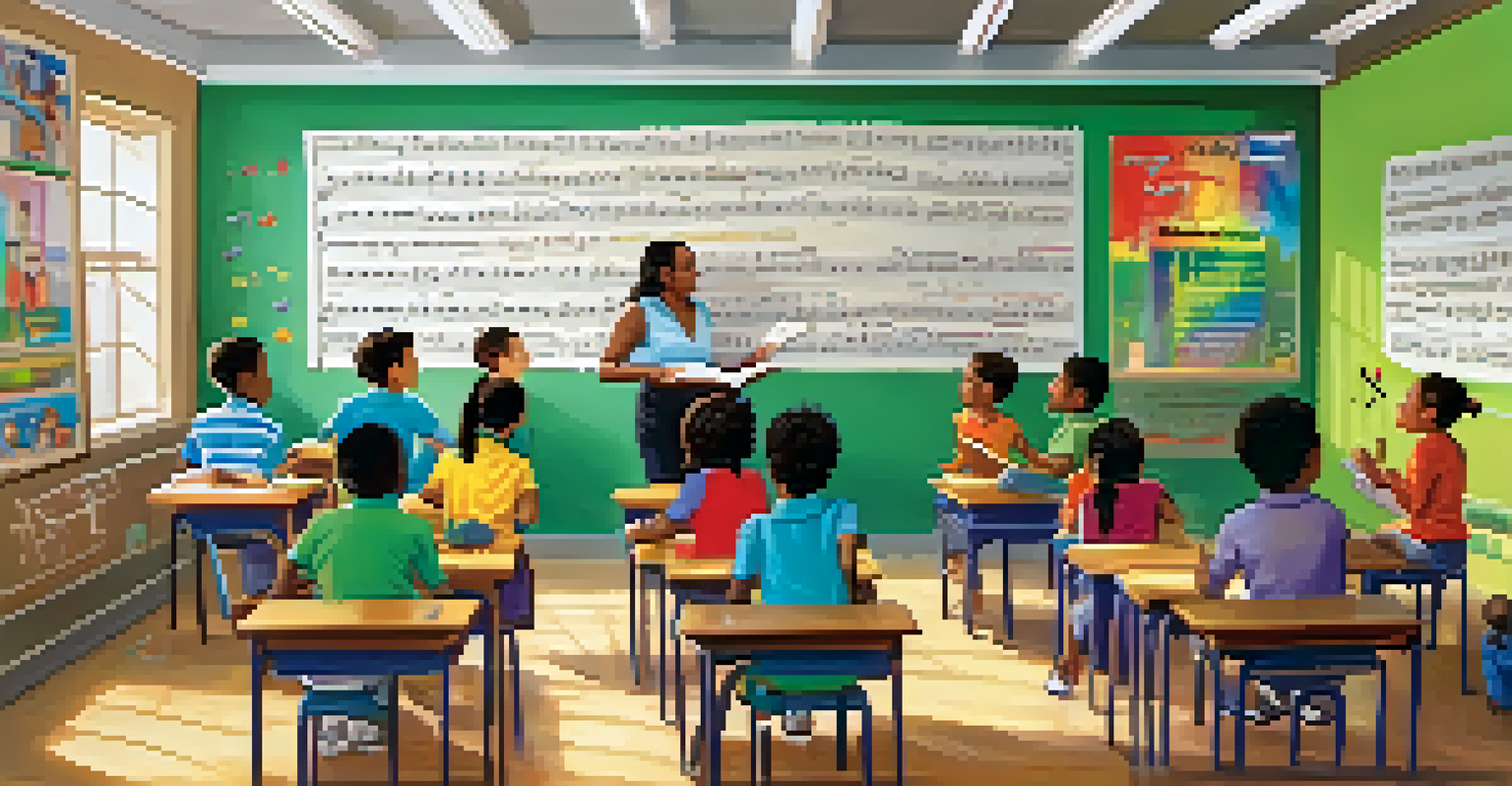The Cultural Significance of Music and Language in Communication

The Fundamental Role of Language in Culture
Language is more than just a means of communication; it is a fundamental part of culture. It allows communities to express their values, beliefs, and traditions. For instance, idioms and expressions often reflect the unique experiences of a culture, making language a living narrative of its people.
Language is the road map of a culture. It tells you where its people come from and where they are going.
Moreover, language shapes our identity and influences how we perceive the world around us. Different languages can evoke different emotions and thoughts, showcasing the diversity of human experience. Take, for example, the way certain words in one language might have no direct translation in another, highlighting cultural nuances.
In essence, the study of language is a window into understanding a culture's psyche. By examining the ways in which language evolves, we can trace the historical and social changes that shape a community's identity over time.
Music: The Universal Language of Emotion
Music transcends linguistic barriers, often referred to as the 'universal language.' Regardless of the words used, music can evoke powerful emotions and connect people on a deeper level. Think about how a melody can stir memories or feelings, even if you don't understand the lyrics.

Different cultures have unique musical traditions that reflect their histories and values. For example, the use of drums in African music often symbolizes community and unity, while classical music in Western cultures might emphasize individual expression and artistry. These differences show how music can articulate cultural identity.
Language Shapes Cultural Identity
Language serves as a vital expression of a community's values, beliefs, and traditions, reflecting its unique experiences.
Ultimately, music acts as a bridge between diverse communities. Through festivals, collaborations, and shared experiences, people can connect and communicate in ways that words alone cannot capture, fostering understanding and solidarity.
The Intersection of Music and Language in Communication
Music and language often intersect, enhancing the way we communicate. Songs can tell stories, convey messages, and express emotions that words alone sometimes fail to capture. For instance, folk songs often narrate historical events, preserving cultural heritage.
Music is the shorthand of emotion.
Additionally, the rhythms and tones of speech can be musical in nature. The way we inflect our voices, emphasize certain words, or use pauses can create a melody in conversation, making communication more dynamic. This interplay enriches our interactions and connects us on a deeper level.
By combining music and language, we create a richer tapestry of communication. This synergy not only enhances artistic expression but also allows for more profound emotional connections among individuals and communities.
Cultural Identity and Music: A Deep Connection
Music is often a reflection of cultural identity, encapsulating the essence of a community’s values and heritage. From traditional folk songs to contemporary genres, music serves as a means of cultural expression. For example, the revival of indigenous music genres helps preserve languages and traditions that may otherwise fade away.
Furthermore, music can foster a sense of belonging among individuals. Participating in cultural music events, such as dances or concerts, allows people to celebrate their shared identity and create lasting memories. These experiences can strengthen communal ties and promote cultural pride.
Music Connects Across Cultures
Music acts as a universal language that transcends barriers, fostering emotional connections and shared cultural experiences.
As such, music plays a vital role in shaping and maintaining cultural identity. By engaging with music, communities can pass down their traditions and stories to future generations, ensuring that their unique heritage remains alive.
The Role of Music in Language Acquisition
Research suggests that music can significantly aid in language acquisition. Children often learn new words and pronunciations through songs, making the process enjoyable and engaging. Nursery rhymes, for example, use melody and rhythm to reinforce vocabulary and phonetic skills.
Moreover, music can help bridge the gap for language learners. By listening to songs in a new language, learners can improve their listening skills and pick up on colloquial phrases that textbooks might miss. This approach can make learning more relatable and fun.
In essence, incorporating music into language learning can enhance retention and comprehension. It's a creative way to support education, making it more interactive and less daunting for learners of all ages.
Challenges and Change: Globalization's Impact
Globalization has significantly impacted both music and language, leading to cultural exchange and hybridization. While this blending can enrich cultural experiences, it also raises concerns about the preservation of traditional practices. For instance, the dominance of Western pop music can overshadow local musical forms, risking their extinction.
Additionally, languages are also at risk as global communication often favors dominant languages, leading to a decline in less widely spoken ones. This language shift can erode cultural diversity and diminish the richness of human expression.
Globalization Challenges Heritage
While globalization promotes cultural exchange, it also threatens the preservation of traditional music and languages.
Thus, while globalization creates opportunities for connection, it also poses challenges for cultural preservation. It's crucial for communities to actively engage in promoting and celebrating their unique languages and music to maintain their heritage in a rapidly changing world.
The Future of Music and Language in Communication
As we look to the future, the relationship between music and language in communication will continue to evolve. Advances in technology, such as AI and streaming platforms, are changing how we create and share music, making it more accessible than ever. This democratization of music allows for a broader exchange of cultural expressions.
Moreover, as global communities become increasingly interconnected, the fusion of different musical styles and languages will create new forms of expression. This cultural blending can lead to innovative collaborations that reflect our diverse society, enhancing understanding and appreciation among different groups.

In conclusion, the future of communication will likely be a rich tapestry woven from the threads of music and language. By embracing this interconnection, we can foster a more inclusive world where every voice and melody contributes to the ongoing dialogue of humanity.